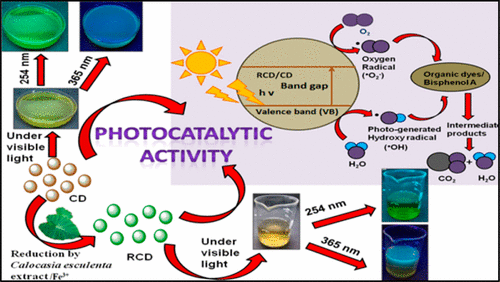当前位置:
X-MOL 学术
›
ACS Sustain. Chem. Eng.
›
论文详情
Our official English website, www.x-mol.net, welcomes your
feedback! (Note: you will need to create a separate account there.)
Facile and Ultrafast Green Approach to Synthesize Biobased Luminescent Reduced Carbon Nanodot: An Efficient Photocatalyst
ACS Sustainable Chemistry & Engineering ( IF 7.1 ) Pub Date : 2017-09-20 00:00:00 , DOI: 10.1021/acssuschemeng.7b02590 Rituparna Duarah 1 , Niranjan Karak 1
ACS Sustainable Chemistry & Engineering ( IF 7.1 ) Pub Date : 2017-09-20 00:00:00 , DOI: 10.1021/acssuschemeng.7b02590 Rituparna Duarah 1 , Niranjan Karak 1
Affiliation

|
Rising awareness pertaining to global waste management and environmental issues challenges the development of an efficient metal-free photocatalytic system for visible light-assisted degradation of organic contaminants. We herein report the synthesis of biobased luminescent reduced carbon nanodots (RCDs) (3 nm average size) by green reduction of starch-based carbon nanodots (CDs) using aqueous extracts of Calocasia esculenta leaf, Mesua ferrea Linn leaf, tea leaf, and flower bud of Syzygium aromaticum. The reduction was found to be ultrafast (3 min) under sonication using Calocasia esculenta leaf extract in the presence of Fe3+ ions at room temperature. The synthesized RCD is an efficient photocatalyst for the degradation of model dirt like methylene blue, methyl orange, and their mixture as well as toxic chemicals like bisphenol A under normal sunlight. These degradations followed the pseudo-first-order kinetics model. The catalytic efficiency of RCD was significantly higher than that of CD. The structure of RCD was characterized by UV–visible, Fourier transform infrared, energy-dispersive X-ray, and Raman spectroscopic analyses as well as X-ray diffraction and transmission electron microscopic studies. The photoluminescence characteristic of RCD was analyzed by fluorescence spectroscopy. The results showed that exploration of sustainable resource-based RCD may offer a novel scope in resolving environmental and ecological problems.
中文翻译:

合成生物基发光还原碳纳米点的便捷,超快绿色方法:高效的光催化剂
关于全球废物管理和环境问题的认识不断提高,对开发有效的无金属光催化系统以可见光辅助降解有机污染物提出了挑战。我们在此报告了绿色合成的生物基发光还原碳纳米点(RCD)(3 nm平均大小)的合成,方法是使用淡水Calocasia esculenta叶,Mesua ferrea Linn叶,茶叶和花朵的水提取物对淀粉基碳纳米点(CDs)进行绿色还原。蒲桃的芽。发现在Fe 3+存在下,使用Calocasia esculenta叶片提取物进行超声处理后,还原速度超快(3分钟)离子在室温下。合成的RCD是一种有效的光催化剂,可在正常阳光下降解亚甲基蓝,甲基橙及其混合物以及双酚A等有毒化学物质等模型污物。这些降解遵循伪一级动力学模型。RCD的催化效率明显高于CD。RCD的结构通过紫外可见光,傅立叶变换红外光谱,能量色散X射线和拉曼光谱分析以及X射线衍射和透射电子显微镜研究来表征。通过荧光光谱分析了RCD的光致发光特性。结果表明,探索基于资源的可持续RCD可能为解决环境和生态问题提供一个新的领域。
更新日期:2017-09-20
中文翻译:

合成生物基发光还原碳纳米点的便捷,超快绿色方法:高效的光催化剂
关于全球废物管理和环境问题的认识不断提高,对开发有效的无金属光催化系统以可见光辅助降解有机污染物提出了挑战。我们在此报告了绿色合成的生物基发光还原碳纳米点(RCD)(3 nm平均大小)的合成,方法是使用淡水Calocasia esculenta叶,Mesua ferrea Linn叶,茶叶和花朵的水提取物对淀粉基碳纳米点(CDs)进行绿色还原。蒲桃的芽。发现在Fe 3+存在下,使用Calocasia esculenta叶片提取物进行超声处理后,还原速度超快(3分钟)离子在室温下。合成的RCD是一种有效的光催化剂,可在正常阳光下降解亚甲基蓝,甲基橙及其混合物以及双酚A等有毒化学物质等模型污物。这些降解遵循伪一级动力学模型。RCD的催化效率明显高于CD。RCD的结构通过紫外可见光,傅立叶变换红外光谱,能量色散X射线和拉曼光谱分析以及X射线衍射和透射电子显微镜研究来表征。通过荧光光谱分析了RCD的光致发光特性。结果表明,探索基于资源的可持续RCD可能为解决环境和生态问题提供一个新的领域。







































 京公网安备 11010802027423号
京公网安备 11010802027423号